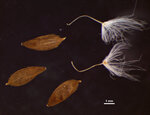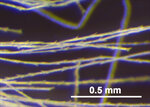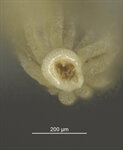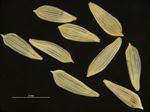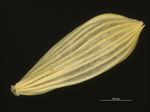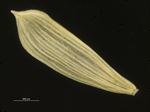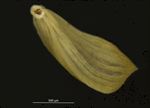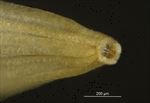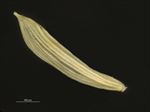Taxonomy
Lactuca sativa L., Sp. Pl. 2: 795. 1753.Common name
Lettuce.
Description
Propagule or dispersal unit is the fruit with pappus. Fertile part 3-4 mm long, 1-2 mm wide, in side view widest in upper part (obovoid) or widest in the middle, conspicuously curved, rarely +/- straight, the upper (apical) end narrowing, in cross-section flattened, basal scar (carpopodium) pronounced and well-differentiated, rarely inconspicuous and undifferentiated, central, beak (=thinner sterile stalk between seed and pappus) present, beak length 0.5-5 mm, wings absent, fruit surface dark brown, rarely light brown or straw or black, smooth (except at cellular level) or wrinkled (by misinterpretation), with no hairs (glabrous), thickened margin absent, longitudinal ribs present, 4-28, their surfaces bumpy or notched, rarely smooth (by misinterpretation), with no hairs (glabrous), simple straight hairs or papillae (small protuberances).
Pappus type bristles / hairs, pappus elements all +/- similar, up to 2.5-6 mm long, in several rows, pappus elements numerous, falling off as a whole or elements falling off individually, the individual bristles rough / serrated (barbellate), +/- equal width along length, white / translucent.
Notes: The surface colour of the fruits appears to vary widely. As the photos show, it can be very pale, but dark brown fruits are more common. At least some specimens examined during work on this key showed fruits with a blackish covering. The beak breaks easily, so that the pappus will presumably often be missing when this species is encountered. The three species of Lactuca covered in this key have very similar fruits, but L. sativa generally has larger fruits than L. saligna and L. serriola (1-2 mm wide versus up to 1.1 mm wide).
Ecology
Annual herb, fruits wind-dispersed. Mediterranean to temperate areas. Widely grown as a leaf vegetable.
Native range
Europe, Northern Africa, temperate Asia.
Introduced range
Cosmopolitan.
Past interceptions (Australia): origins
United States, China.
Other or unidentified species of the genus also from Canada, Netherlands, Italy, Kenya, Japan.
Past interceptions (Australia): commodities
Grain, bagged organic fertiliser.
Other or unidentified species of the genus also in/on containers, sawn timber, agricultural machinery, dried medicinal herbs, new vehicles, used vehicles, cut flowers, seeds for sowing.

